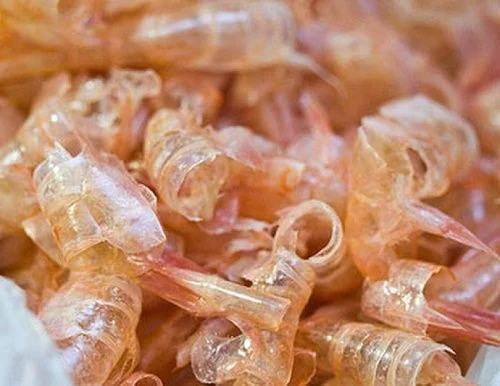
The global shrimp industry generates a significant volume of by-products such as heads and shells, which often account for up to 50% of the total weight. Traditionally considered waste, these materials are actually a rich source of proteins, lipids, and valuable compounds. A recent scientific study explores an innovative way to utilize them: controlled fermentation to develop a value-added product with notable benefits for human health.
The research, published in the journal Applied Food Research by researchers from Prince of Songkla University, focuses on transforming the “problem” of waste into a circular economy solution by creating a fermented shrimp paste (FSP) that not only has potential as a new food product but also as a functional ingredient.
The challenge: Turning waste into value
Shrimp processing leaves behind a large amount of biomass that, if not managed properly, poses an environmental challenge and an economic cost. However, these by-products contain bioactive compounds of great interest. The key is how to “release” and make these compounds accessible in order to valorize the shrimp by-products.
Fermentation, an ancient biotechnological technique, presents itself as an ideal tool. Through the action of specific microorganisms, it is possible to break down the complex protein structures of the by-products into smaller molecules, such as peptides, which can have direct positive effects on health.
Fermentation with a starter culture
To carry out the study, the researchers did not leave the fermentation to chance. They used a controlled and standardized approach to ensure the quality and safety of the final product.
- By-product preparation: By-products from the Penaeus monodon shrimp species were used, which were steamed, dried, and ground into a fine powder.
- Microorganism selection: The powder was inoculated with a starter culture of Tetragenococcus halophilus, a halophilic (salt-tolerant) bacterium known for its role in producing high-quality fermented foods in Asia, such as soy sauce and fish pastes.
- Fermentation process: The mixture was incubated for 15 days, a period during which the bacteria worked to break down the proteins and develop the sensory and functional characteristics of the paste.
- Analysis: Finally, the properties of the resulting fermented paste were evaluated, including its chemical composition and, most importantly, its ability to act on health indicators.
Beyond nutrition
The study yielded promising results that position this fermented shrimp paste as a high-potential functional ingredient.
- High peptide content: Fermentation significantly increased the amount of soluble peptides. These small protein fragments are responsible for the observed bioactivities.
- Potential against hypertension: The paste’s ability to inhibit the Angiotensin-Converting Enzyme (ACE) was measured. This enzyme plays a key role in regulating blood pressure, and its inhibition is the mechanism of action for many antihypertensive drugs. The fermented shrimp paste showed notable ACE-inhibitory activity, suggesting a potential benefit for cardiovascular health.
- Anticancer activity: The effect of the paste’s extracts on cervical cancer cell lines (HeLa) was evaluated. The results indicated that the fermented paste possessed significant cytotoxic activity against these cancer cells, inhibiting their growth in a dose-dependent manner. It is important to note that this activity was specific to cancer cells, showing low toxicity in healthy cells.
Implications for the aquaculture sector and the food industry
The findings of this research open a valuable door for the aquaculture industry, aligning with the growing demands for sustainability and a circular economy.
- Integral valorization: It allows for the transformation of a costly waste into a high-value-added product, diversifying revenues and reducing environmental impact.
- New markets: The fermented paste could be marketed as a condiment (similar to other Asian seafood pastes) or as a functional ingredient to enrich other foods with bioactive peptides.
- Sustainability: It promotes a “zero-waste” production model, improving the overall sustainability of the shrimp sector. For a producer, this not only means a new source of income but also an improvement in image and compliance with increasingly strict environmental regulations.
Conclusion: A new era for shrimp by-products
This study scientifically demonstrates that shrimp by-products are much more than waste. Through a controlled biotechnological process like fermentation with Tetragenococcus halophilus, it is possible to develop a fermented shrimp paste that is not only safe and nutritionally rich but also possesses important functional properties, with the potential to contribute to the prevention and management of chronic diseases like hypertension and cancer.
Stay Always Informed
Join our communities to instantly receive the most important news, reports, and analysis from the aquaculture industry.
The research underscores the importance of continuing to explore the hidden potential in aquaculture co-products, transforming what was once a problem into an opportunity for innovation, health, and sector sustainability.
Contact
Sunisa Siripongvutikorn
Centre of Excellence in Functional Foods and Gastronomy, Faculty of Agro-Industry, Prince of Songkla University
Hat Yai, Songkhla, 90110, Thailand.
Email: Sunisa.s@psu.ac.th
Reference (open access)
Rujirapong, C., Siripongvutikorn, S., Suyotha, W., & Cheirsilp, B. (2025). Possibility to utilize shrimp by-product as a fermented food and its health benefits on hypertension and cancer. Applied Food Research, 101142. https://doi.org/10.1016/j.afres.2025.101142
Editor at the digital magazine AquaHoy. He holds a degree in Aquaculture Biology from the National University of Santa (UNS) and a Master’s degree in Science and Innovation Management from the Polytechnic University of Valencia, with postgraduate diplomas in Business Innovation and Innovation Management. He possesses extensive experience in the aquaculture and fisheries sector, having led the Fisheries Innovation Unit of the National Program for Innovation in Fisheries and Aquaculture (PNIPA). He has served as a senior consultant in technology watch, an innovation project formulator and advisor, and a lecturer at UNS. He is a member of the Peruvian College of Biologists and was recognized by the World Aquaculture Society (WAS) in 2016 for his contribution to aquaculture.




